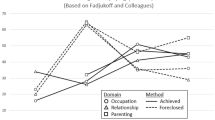Abstract
A new developmental stage called the quarter-life is proposed, extending from approximately 18–29 years of age and sometimes later. The emergence of this period is believed to be the result of several social, historic and economic factors that occurred post WWII. This article explores these changes in terms of the experiences of affluent young people in today’s Western society. A typology of adaptational responses are presented and explored as the quarter-lifers attempt to navigate their way to adulthood within the context of this ‘new’ affluent society. Implications for family therapists are considered.
Similar content being viewed by others
References
Adams, J. (2004). The kids aren’t all right. Retrieved February 2005 from http://saqonline.smith.edu/article.epl?issue_id=4&article_id=141.
Anderson, H., & Goolishian, H. (1988). Human systems as linguistic systems: Preliminary and evolving ideas about the implications for clinical theory. Family Process, 27(4), 371–393.
Arnett, J. (1997). Young peoples’ conceptions of the transition to adulthood. Youth and Society, 29, 1–23.
Arnett, J. (1998). Learning to stand-alone: The contemporary American transition to adulthood in cultural and historical context. Human Development, 41, 295–315.
Arnett, J. (2001). Emerging adulthood: A theory of development from the late teens through the twenties. American Psychologist, 55, 469–480.
Arnett, J. (2004). Emerging adulthood: The winding road from the late teens through the twenties. New York: Oxford University Press.
Bateson, G. (1972). Steps to an ecology of mind. New York: Ballantine Books.
Becvar, D., & Becvar, R. (1999). Systems theory and family therapy: A primer. Lanham, MD: University Press of America.
Berger, P., & Luckman, T. (1966). The social construction of reality: A treatise in the sociology of knowledge. New York: Anchor.
Bordo, M., Taylor, A., & Williamson, J. (2005). Globalization in historical perspective. National Bureau of Economic Research Conference Report.
Day, D., Peterson-Badali, M. & Shea, B. (2002). Parenting style as a context for the development of adolescent’s thinking about rights. Retrieved February 12, 2008, from http://www.eric.ed.gov/ERICWebPortal/custom/portlets/recordDetails/detailmini.jsp?_nfpb=true&_&ERICExtSearch_SearchValue_0=ED464746&ERICExtSearch_SearchType_0=no&accno=ED464746.
de Shazer, S. (1998). Clues: Investigating solutions in brief therapy. New York: W.W. Norton.
Draut, T., & Silva, J. (2004). Generation broke: The growth of debt among young americans. Borrowing to make ends meet series. Retrieved May 2005 from http://www/demosusa.org/pubs/Generation_Broke.pdf.
Durkheim, E. (1898; 1951). Suicide. Glencoe, IL: Free Press.
Epston, D., & White, M. (1990). Consulting your consultants: The documentation of alternative knowledges. Dulwich Center Newsletter, p. 4.
Erikson, E. (1950). Childhood and society. New York: Norton.
Erikson, E. H. (1968). Identity: Youth and crisis. New York: Norton.
Freedman, J., & Combs, G. (1996). Narrative therapy: The social construction of preferred realities. New York: Norton.
Gordon, L. P., & Shaffer, S. M. (2004). Mom, can I move back in with you? A survival guide for parents of twenty some things. New York: Tarcher.
Grossman, L. (2005). Grow up? Not so fast. Time. January, pp. 42–54.
Hall, G. S. (1904). Adolescence, its psychology and its relations to physiology, anthropology, sociology, sex, crime, religion and education. New York: Appleton.
Infoplease. (2000–2005). Household and family statistics. Retrieved October 13, 2005 from http://wwwinfoplease.com/ipa/A0922218.html.
Jonsson, B. (1994). Youth life projects and modernization in Sweden: A cross-sectional study. San Diego, CA: The Society for Research on Adolescence.
Kamenetz, A. (2005). Rich little ‘poor’ kids. Village Voice. Retrieved November 2005, from http://www.villagevoice.com/news/0530,kamenetz,66195,6.html.
Larson, R. W. (1990). The solitary side of life: An examination of the time people spend alone from childhood to old age. Developmental Review, 10, 155–183.
Levinson, D. J. (1986). A conception of adult development. American Psychologist, 41, 3–13.
McNamee, S. (2002). Reconstructing identity: The communal construction of crisis. In S. McNamee & K. J. Gergen (Eds.), Therapy as social construction (pp. 186–199). London: Sage.
Merton, R. K. (1938). Social structure and anomie. American Sociological Review, 672–682.
Mills, M., & Blossfeld, H. (2003). Globalization, uncertainty and changes in early life courses. Springerlink, 6(2), 188–218.
Mintel Report. (2004). Lifestyles of young adults. Chicago: Mintel International Group, Ltd.
Montemayor, R., Brown, B., & Adams, G. (1985). Changes in identity status and psychological adjustment after leaving home and entering college. Toronto, Canada: Society for Research on Child Development.
National Marriage Project. (2000). Sex without strings, relationships without rings: Today’s singles talk about mating and dating. Retrieved February 17, 2008, from http://marriage.rutgers.edu/Publications/Print/Print%20SEX%20WITHOUT%20STRINGS.htm.
O’Hanlon, B., & Bertolino, B. (1998). Even from a broken web: Brief, respectful solution-oriented therapy for sexual abuse and trauma. New York: Wiley.
Robbins, A. (2004). Conquering your quarterlife crisis: Advice from twentysomethings who have been there and survived. New York: Berkeley Group.
Robbins, A., & Wilner, A. (2001) Quarter life crisis: The unique challenges of life in your twenties. New York: Tarcher/Putnam.
Seeman, M. (1976). On the meaning of alienation. In L. A. Coser & B. Rosenberg (Eds.), Sociological theory (pp. 401–414). New York: MacMillan.
Simon, W., & Gagnon, J. (1976). The anomie of affluence: A post-Mertonian conception. The American Journal of Sociology, 82(2), 356–378.
Taffel, R. (2001). The second family. New York: St Martin’s Press.
U.S. Census Bureau. (2003). American community survey summary tables. American Fact Finder, Tables P004. P005.
Walsh, F. (1998). Strengthening family resilience. New York: Guilford Press.
Waterman, A. (1982). Identity development from adolescence to adulthood: An extension of theory and a review of research. Developmental Psychology, 18, 341–358.
Watts, A. (1972). The art of contemplation. New York: Pantheon Books.
Watzlawick, P. (1978). The language of change: Elements of therapeutic communication. New York: Norton.
White, M., & Epston, D. (1990). Narrative means to therapeutic ends. New York: W.W. Norton.
World Youth Report. (2003). Young people in a globalizing world. Retrieved July 15, 2006, from http://www.un.org/esa/socdev/unyin/wyr03.htm.
Zimmerman, J., & Dickerson, V. (1994). Using a narrative metaphor: Implications for theory and clinical practice. Family Process, 33(3), 233–245.
Acknowledgement
A special note of thanks to Ian Nichols who assisted in the initial stages of this work.
Author information
Authors and Affiliations
Corresponding author
Rights and permissions
About this article
Cite this article
Atwood, J.D., Scholtz, C. The Quarter-life Time Period: An Age of Indulgence, Crisis or Both?. Contemp Fam Ther 30, 233–250 (2008). https://doi.org/10.1007/s10591-008-9066-2
Received:
Accepted:
Published:
Issue Date:
DOI: https://doi.org/10.1007/s10591-008-9066-2




